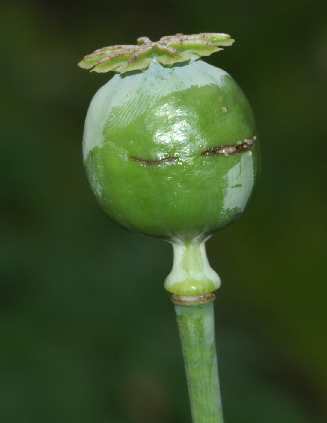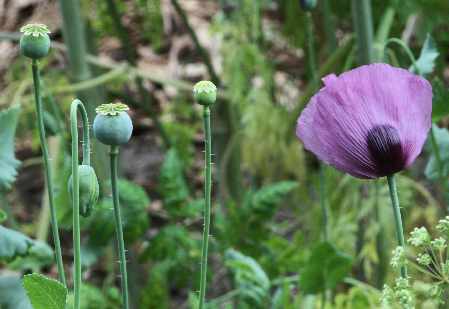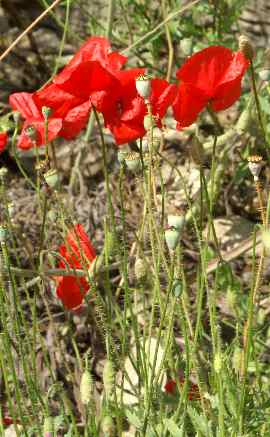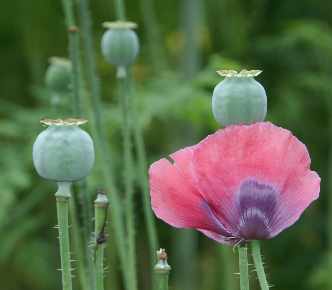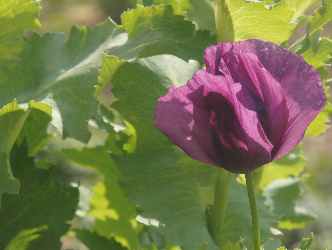
|
| Opium poppy flower |
The Homeric epics are full of details of preclassic Greece — yet
nutrition is quite neglected. Several kinds of cereals and breads are
mentioned, but most amazingly, fish never appears on the table. One
gets the impression that Bronze Age warriors were most fond of meats:
dainymenoi krea t’ aspeta kai methy hedy
[δαινύμενοι
κρέα
τ’ ἄσπετα
καὶ
μέθυ ἡδύ]
feasting on abundant flesh and sweet wine
and
krea amph’ obeloisin peirein optan te periphradeos
[κρέα
ἀμφ’
ὀβελοῖσιν
πείρειν
ὀπτᾶν
τε
περιφραδέως]
put meat on spits and roast it carefully
are phrases the poet repeatedly
chooses to describe the numerous feasts. The phrase methy hedy
sweet wine
is linguistically interesting, because both words derive
from roots meaning sweet
, but yet they are not akin to each other;
see bear’s garlic and licorice for further explanations.

|
| Flowering poppy plants |
| ||
|
Besides poppy, Homer mentions several other food plants: The most frequent
references go to olives (olive oil,
elaion [ἐλαίον]
and olive tree,
elaia [ἐλαία]), and even
onion has an emergence as foodstuff
(krommyon [κρόμμυον],
see also bear’s garlic). Furthermore, a plant
named selinon [σέλινον]
appears which translators identify either as celery
or parsley. The hues of Dawn (the goddess
Eos [Ἠῶς])
are compared both with rose flowers
(rhododaktylos [ῥοδοδάκτυλος]
rosy-fingered
) and with saffron threads
(krokopeplos [κροκόπεπλος]
saffron-robed
).
Lastly, in the Odysseia there is mention of an enigmatic plant
moly [μῶλυ],
which is used as a protection against evil magic powers. The word
is sometimes speculated to mean garlic
or a close relative; but the most common name of garlic in Classical
Greek is skorodon [σκόροδον].
Others think it might have been snowdrop (Galanthus nivalis),
whose genus name means milk flower
, quite in accord with Homer’s
description: galakti de eikelon anthos
[γάλακτι
δὲ
εἴκελον
ἄνθος]
yet the flower (was) like milk
.
Homer’s influence for the further cultural development of Europe is
unquestioned. When, approximately in Homer’s lifetime, Greek culture rose to
new glory with its sport festivals (see bay leaves
about the Olympic Games), its poets and philosophers, the Greeks considered
the events described in the Ilias and the
Odysseia as belonging to their own great past. During the largest
part of antiquity, Homer was called the divine poet
. Interest in ancient
poetry declined after the fall of the Roman Empire, but more than a millennium
later, during the European Renaissance, the educated class again began to read
Homer. The interest in classic antiquity culminated in the excavation of the
stage of Homer’s Ilias, ancient Troia, by H. Schliemann
at the archeological site known as Hisarlık.
Although Homer is no longer taught in school, quotations from his work have
survived even in today’s vernacular: So we speak of Homeric laughter
(used
to stimulate the lust for battle), of
winged words
(epea pteroenta [ἔπεα πτερόεντα]:
words designed to fly
to the interlocutor) and who has
not ever heard of
Skylla [Σκύλλα]
and Charybdis [Χάρυβδις],
two evils only one of which can be avoided?
The ancients valued poppy for the oil obtained from its seeds, which was put to culinary use. Ancient Greek physicians also knew about the narcotic and analgesic power of opium; however, Medieval European medicine did not use opium, partly because of religious bias against pain-reducing agents. Opium and its derivatives as illegal and addictive drugs are a comparatively young development in Europe.
Ancient sweetmeats and cakes often contained poppy seeds, frequently together with
almonds or sesame seeds.
These sweets were usually slightly peppered, which is
a characteristic feature of ancient Mediterranean cooking (see also
silphion on ancient Roman cuisine).
The recipes moved from Rome to Byzantium, whence they entered the
cuisines of Islâmic states in the Near East. An example is
Turkish baklava
(Greek baklava [μπακλαβά],
Arabic baqlava [بقلاوة]),
a mixture of honey and nuts wrapped in fillo [φύλλο] leaves.
Its predecessors can be traced back to pre-Hellenistic Greece.
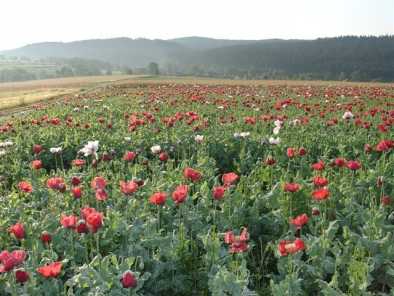
|
| Austrian poppy field |
By transmission of the Ottoman Turks, the Near Eastern recipes entered
Eastern Europe (Bulgaria, Hungary) and finally arrived in Austria during
the Austro–
The Austrian pastry known as Strudel (sometimes spelled shtrudel in English) consists of
extremely thin, almost transparent, sheets of highly elastic dough (shaped and pulled by hand)
enshrouding stuffings prepared with nuts, fresh cheese (Topfen) or fruits; poppy seeds are
a very popular choice. Strudel is usually eaten dry;
in our days, one sees it often served with a sweet
vanilla sauce, which most Austrians consider
an abomination. Common flavourings for the stuffing include
lemon or orange
zest (fresh or candied) and cinnamon. Many
stuffings contain also raisins.
In Hungary, there are savoury types of Strudel,
e. g., with a paprika-flavoured cabbage stuffing
(káposztás rétes), which have also been
transferred to the Eastern parts of Austria.
Another great example for Austrian sweet cuisine utilizing poppy seeds is
Germknödel, a large
yeast dumpling stuffed with a very concentrated kind of plum jam
(Powidl). Germ means
Pastry stuffed
Poppy oil, formerly an important foodstuff, is now a rare specialty and is produced only in small
quantities; most common is a cold-
In Asia, poppy is also much cultivated, yet mostly not for culinary purposes, but
for the production of opium. Actually, the infamous
In China, the British won the two Opium Wars (ya pian zhan zheng [鸦片
Yet in Asia poppy is not unknown for cooking, either. Ground poppy seeds are a
common thickening agent in the Moghul cooking style of Northern India (see onion and black cumin); a
special crème–white variety was bred for light sauces. The cuisine of
Bengal in North-East India often uses poppy, which harmonizes perfectly well
with that lightly-flavoured cookind style (see also nigella). Poppy’s nutty taste is
loved by the Japanese and used for the subtly flavoured dishes typical for
Japan. The Japanese spice mixture shichimi togarashi (see Sichuan pepper) contains poppy seeds.
flour foods
)
are typical for Austrian cuisine, and are often even served as a main course.
yeast
in Austria, although this is not standard German. The dumplings are
steamed and served with powdered sugar, ground poppy seeds and molten butter.
The recipe was introduced to Austria
from Bohemia, today’s Czech Republic, where the dumplings are known as
kynuté knedlíky.
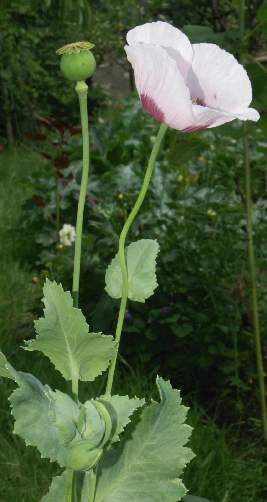
Poppy plant, flowering
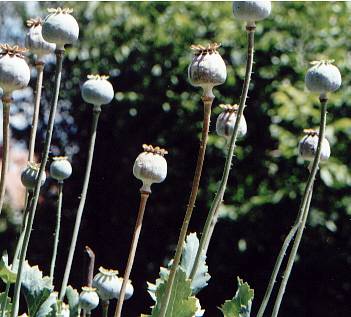
Poppy (plant with close to ripe capsules)
poppy pockets
)
are known in various Central and Eastern European countries; they are
particularly associated with Yiddish baking
(homentashn [המנטאַשן] or
montashn [מאָנטאַשן]).
France has croissants
with poppy stuffings. Poppy seeds are often sprinkled on the surface of pastries,
particularly of the lye roll type, to develop a nutty flavour during the baking.
This usage parallels that of sesame and nigella seeds in the Middle East.
Golden Triangle
located at the border between Thailand, Burma and Laos is not one of the most
important production areas, since better alkaloid yields are archived at higher
altitude. Hill tribes in these three countries and also in Vietnam and China
use opium as the single traditionaly luxury their hard life permits; the
introduction of opium to ethnic Chinese or Vietnamese is, however, a result of
the colonial era and particularly due to French and British politics. Other
than in communities with a long tradition of opium smoking, the poison had
fatal consequences in both Vietnam and China.


